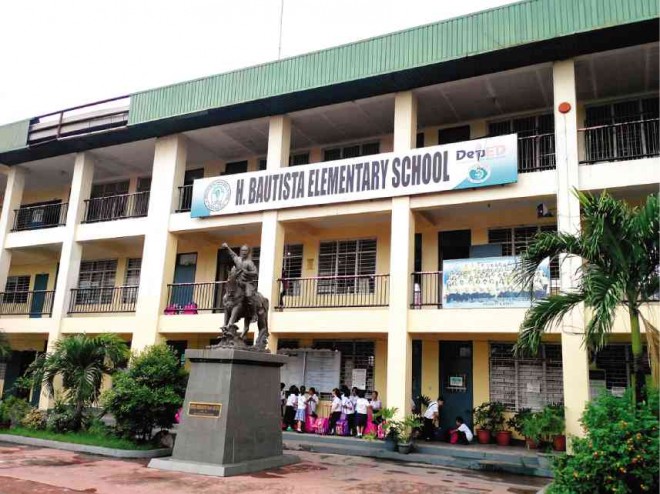Rebuilding disaster victims’ lives begins at evacuation center

AT HERMOGENES Bautista Elementary School (left), evacuees are encouraged to care for their temporary shelter like it is their own home
Evacuation centers in the country are usually associated with desperation, filth and stink.
But when habagat (southwest monsoon) caused flooding in Metro Manila in August last year, Hermogenes Bautista Elementary School (HBES) was left by evacuees smelling of fabric conditioner.
Evacuees at the public elementary school in Marikina City busied themselves cleaning up their temporary shelter during their weeklong stay. They waxed the floors and wiped them—and the walls—with rags moistened with the popular Downy fabric conditioner to ensure that the rooms were clean and fragrant.
Principal Remia Ricabar said she had always told the evacuees to “feel at home and treat the school like their own home.”
Aside from the reminder, Ricabar also conducted a contest for the best room, with the winners receiving rice, as the school received six sacks of the staple, although the prize was not announced.
In desperate times such as calamities, Ricabar said, the best thing to do was to come up with activities that would promote camaraderie, ease the evacuees’ burden and give them hope.
Since the donation was not enough for the school’s 4,197 evacuees, an evaluation team composed of teachers chose five winners based on Ricabar’s version of KKK—kalinisan (cleanliness), kaayusan (orderliness) and kapayapaan (peace).
Five sacks of rice were given to the five winning rooms, which were divided among the five to 10 families occupying each room. The sixth sack was set aside for the school’s feeding program for its students.
“The evacuees went home with a smile, some even with prizes,” Ricabar said. “We might not have been able to give prizes to all of them but at least they were happy.”
Ricabar believed it was not the prize, which was unannounced, that motivated the evacuees but the chance to be appreciated and recognized for their efforts.
Human nature
“It’s human nature to seek recognition,” she said.
One of the evacuees even gave her a letter thanking her for the sincerity and concern that she showed during their stay.
“Nagpapasalamat kami kasi ngayon lang kami nakaranas ng evacuation center na mapayapa. May pa-contest pa at may naiuwi pa kaming bigas (We thank you because, for the first time, we experienced a peaceful evacuation center. There was also a contest and we were able to bring home rice),” the letter read.
Ricabar said she cried as she read the letter. It made all her efforts worthwhile, she added.
While the evacuees were in the school, it was also Ricabar’s home. She slept on a small sofa in her office.
Managing an evacuation center was not easy, she admitted.
There were challenges such as outsiders queuing for relief stocks, which they distributed based on their list of registered evacuees. Each room had a leader, either a teacher or a volunteer, who checked on the evacuees.
“You can’t blame the outsiders because those were desperate times,” she said. “But we had to prioritize those on the list because they were the legitimate recipients.”
Ricabar said she asked the outsiders to wait until all the registered evacuees had received their share.
“There is always something for everyone,” she said.
HBES has a disaster management team that handles room assignment, support staff and food distribution.
The city government also set up a kitchen, assigned personnel to prepare lunch, breakfast and dinner for the evacuees, and had a group to repair facilities and maintain the school’s cleanliness.
Last year was Ricabar’s first term as principal.
Her cleaning contest idea earned positive feedback. And now she wants to initiate programs that will help victims, especially children, overcome the trauma of a disaster and allow them to continue learning, even when the school is being used as an evacuation center.
Online teaching
One of the school’s programs is online teaching, with teachers posting lessons on Facebook and other social networking sites or group accounts.
Teachers and support staff or volunteers can also gather children and form small groups for storytelling and art activities to ease stress and trauma.
Half of the population in evacuation centers are usually children. Evacuating and climbing to the roof for safety when it rained was traumatic for them, Ricabar said.
Teachers are trained to counsel children and assure them that “you are safe here.”
The principal hopes to have more big books, illustrated books and additional art materials. But, she said, such things were expensive and the school did not have a budget for these because its budget for maintenance and other operating expenses paid for utilities.
Through arts and storytelling, the kids were able to express themselves and release negative emotions, she said.
As adults also need to be relieved of stress, Ricabar plans to stage a concert or a videoke contest the next time HBES is used as an evacuation center.
Qualified contestants must belong to the cleanest rooms, she said.
“What we want is to lessen desperation and self-pity,” Ricabar said, “to stop them from thinking that they are in a helpless situation and to make them feel lucky because a lot of people are willing to help.”
